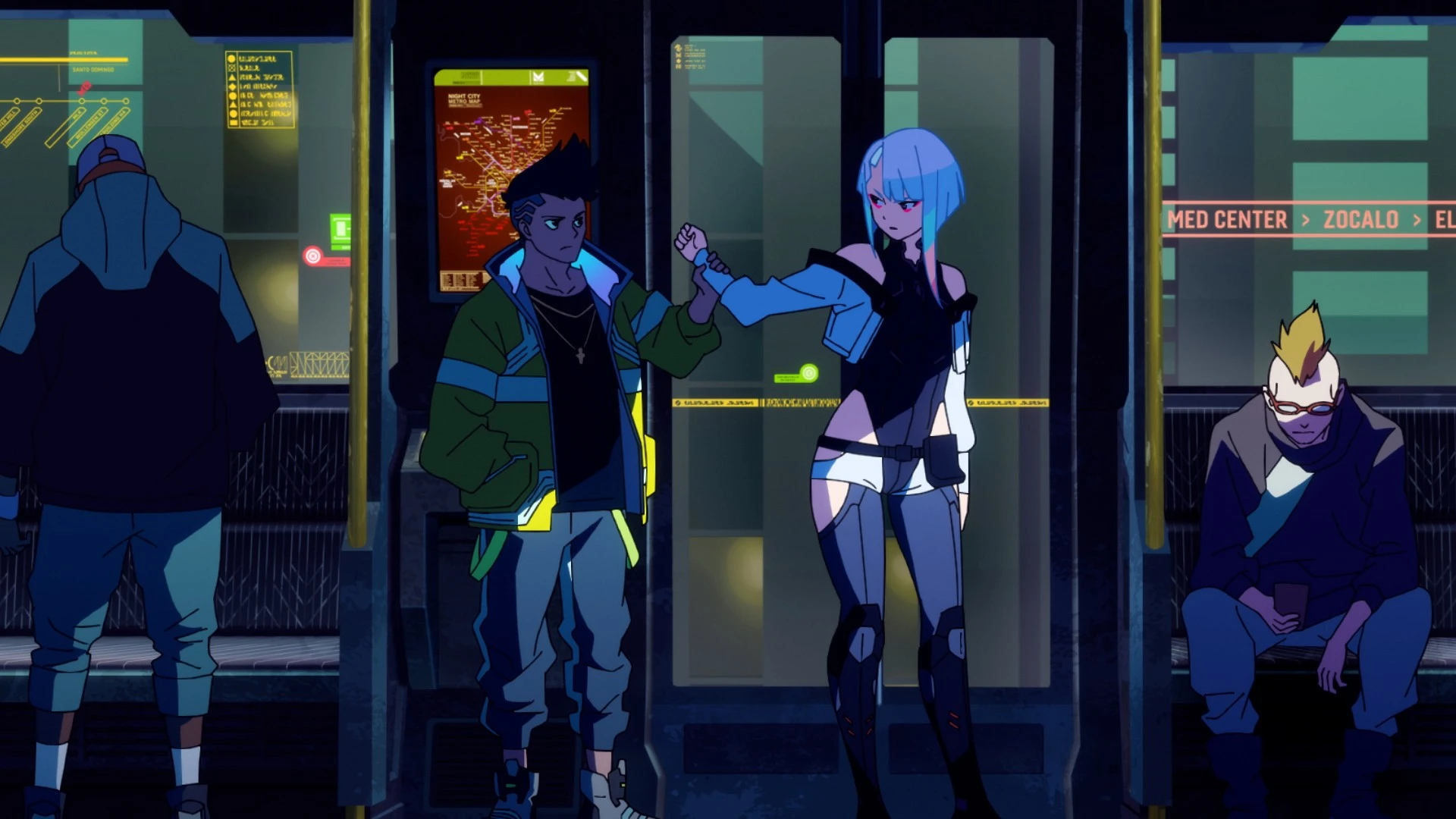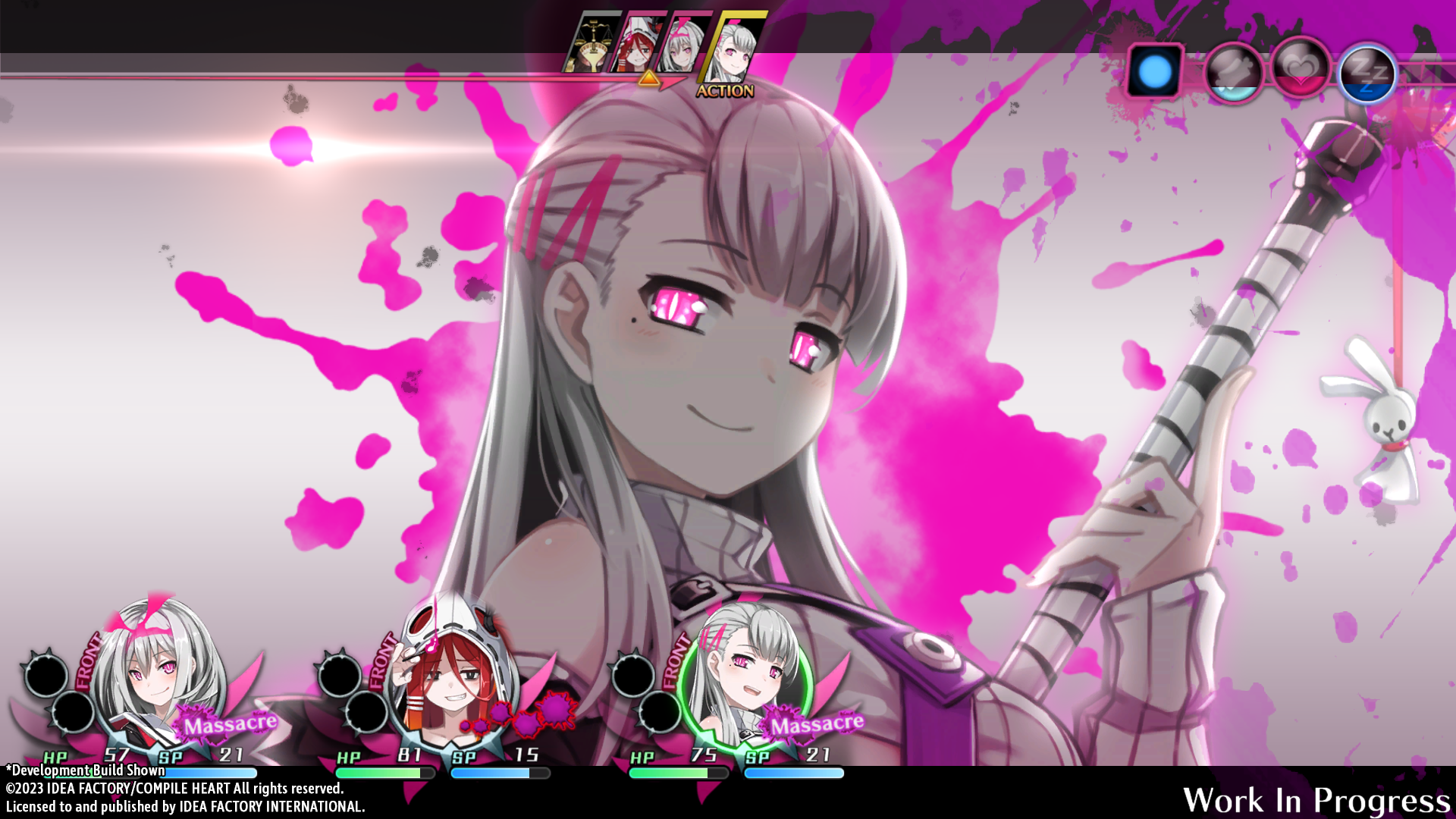Cyberpunk: Edgerunners is a strangely triumphant production. By rights, it shouldn’t even exist. Cyberpunk: Edgerunners is a 2022 anime spinoff of the 2020 video game Cyberpunk 2077 from Polish game developers CD Projekt Red, itself an adaptation of Mike Pondsmith’s 1988 pen and paper role playing game Cyberpunk (later Cyberpunk 2020 and Cyberpunk Red).
So what does a Polish video game studio adapting an American pen and paper role playing game do with the license next?
They make an anime.
Cyberpunk: Edgerunners is the result. Game developers CD Projekt Red partnered with Polish story writers, renowned Japanese animation studio Trigger, and American streaming platform Netflix to create this strange mishmash of international money and talent.
And it works.
Cyberpunk: Edgerunners follows David Martinez, a poor but smart kid in Night City. David attends a prestigious school run by megacorp Arasaka; the exorbitant fees are paid for by his hard-working paramedic mother. When his mother is abruptly killed in a car crash caused by rampaging gangs, David has to grow up fast, installing some black-market military implants that his mother had scavenged from a corpse and dropping out of school. Here he meets Lucy, a beautiful hacker thief – a netrunner – who introduces him to her boss Maine and the rest of his gang of mercenary edgerunners. Finding he has an aptitude for implants and the mercenary lifestyle, David quickly adapts, becoming firm friends with his crew and falling in love with the mysterious Lucy. But can he escape his past trauma? And what dangerous secrets are Lucy and the crew hiding?
Themes of trauma, trust, and expectations are a through line, with every character fundamentally broken in some way or another. Death is common, but still impactful. Night City has abused and spat out these struggling people, leaving them deeply damaged. And, although they are all strong in their own ways, nobody can escape the trauma of their past. These characters never had a chance to begin with, and the narrative conclusion is as terrible as it is inevitable. Cyberpunk: Edgerunners is a Tragedy.
I think what undermined Cyberpunk 2077’s true cyberpunk anti-corporate message was its desire to be such a large game. 2077 was a player choice-driven role playing game first and foremost. Its goal was to provide every player a valid way to get from start to finish, with whatever choices they wished. This is good for a role playing game. It is bad for telling a taut narrative with deep and resonant themes. Cyberpunk 2077 shows the classic problem emerging from the confluence of narrative and ludology – ludonarrative dissonance.
Cyberpunk: Edgerunners solves that problem. Edgerunners has a single laser focus on its narrative, and it runs on the edge of this razor blade. While it may not be the deepest, most ponderous examination of rampant capitalism or the Theseus’ Ship nature of human cyberisation, it is perhaps – thanks in part to Trigger’s vibrant and eclectic art and animation – one of the slickest.
To be clear, there is a prominent thematic thread revolving around the price and worth of a person’s humanity under extreme capitalism. Healthcare is cutthroat, with David’s mother dying due to not having health insurance, despite being a paramedic. David is seen by Arasaka corpos as little more than a potential lab rat for a technology designed to win a technological race. Rival corporation Militech is willing to retrieve that technology at the cost of very real human lives. And death is cheap entertainment, with David selling black market snuff films as a student. The animation itself treats human bodies with disdain, meat to be chopped and pounded and exploded in lavish displays of ichor – and their metal parts to be recycled and reused by the highest bidder.
Hell, the main narrative driving force is cyber psychosis – a psychological condition caused by a person implanting too much technology and literally losing their humanity. Lucy’s story of being an orphan raised by a corporation to be used as a hacker, like a child soldier, almost seems to be gilding the lily.
Edgerunners presents all this as text, layering its ideas but never exploring them too deeply. In a way it doesn’t have to. Cyberpunk 2077 was not a deep or introspective exploration of the human condition, so Edgerunners doesn’t have to be either. But it is more focused on the story it wants to tell, and that solidifies its thematic foundations and allows them to shine. It skips along its svelte ten-episode runtime, never lingering too long on one idea before moving along to the next related thought, but also managing to catch all its spinning plates at the end. It is, for a spinoff, very impressive.
Watch: Anno: Mutationem is the good kind of cyberpunk. We streamed the first hour or so of the game.
And Cyberpunk Edgerunners is squarely spinoff of the Cyberpunk 2077 video game. It is intrinsically linked on such a deep level to the game’s imagining of Night City. From perfectly replicated architecture, to weapon designs, to apartment layouts, and even audio cues and UI elements lifted directly from the game, Edgerunners takes the world established in the game and distils it into anime form. There is no way anyone could mistake which media came first – Edgerunners is a clear spinoff of 2077.
On a technical level, Cyberpunk Edgerunners is definitely let down by its platform. Netflix’s player still lacks the ability to handle subtitles effectively. Thankfully, being designed with an English- speaking audience in mind, and based on an English-language game and all the graphic design that entails, there is very little on-screen text that needs translating, meaning Netflix’s inability to render more than one line of subs at a time isn’t a huge drawback.
More interestingly, there was an issue with the English closed captions on release. Frankly, the closed captions were atrocious. Mistakes were everywhere in the closed caption track, with many words completely misconstrued. For example, “ripper” was often rendered as “reaper”, only to later be correctly written as “ripper”. It felt as if it was carelessly machine transcribed, instead of directly using the English dialogue translation text. Netflix has since “patched” the closed captions, which is a very strange thing to say about a show. I guess everything related to CDPR’s Cyberpunk project needed a post-launch patch to work.
At least the English translation for the dub is good. Actually, it’s fantastic. The language and cadence really captures the feel of the video game, with Edgerunners wielding its jargon and vulgarity like a baseball bat. Of course, it’s nowhere near a literal translation from the Japanese – which would be bland and completely unlike the flavourful language of the game. The localisation team on the anime are clearly very familiar with the original game’s vision, localising the less-obscene Japanese script into one that would slot right into the video game. The dub performances are pretty decent too. Netflix even offers a close caption of the dub as well as a slightly different English sub, so English speakers can choose which one they prefer. I watched in Japanese audio with English closed captions and really liked the mix – once I started working with the patched captions, that is.
Cyberpunk Edgerunners is the rare video game anime adaptation that works. It keeps the aesthetic of the original in the right places, remixes its themes into a tight narrative, and never overstays its welcome. Edgerunners understands that the best parts of Cyberpunk 2077 were its setting and aesthetic, and lovingly realises it in hyperkinetic animation. It may not be the most cyberpunk anime out there, but it is definitely the most cyberpunk version of Cyberpunk.
Please note: This was originally published in the November 2022 edition of the Dee Dee Zine. Because we’ve stopped publishing that magazine we’ve republished the feature here to preserve it.















